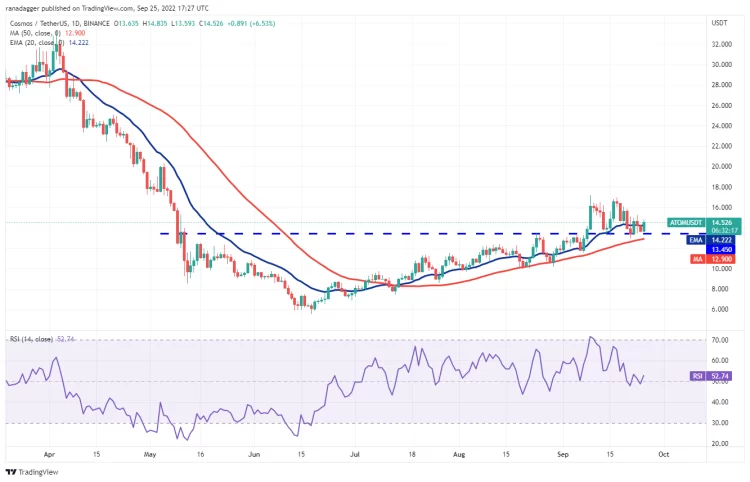Advertisement
Major U.S. stock market indexes continued to fall last week as worsening macroeconomic conditions heightened fears of a global recession. The Dow Jones Industrial Average closed at its lowest level in 2022, and major indexes recorded weekly closes in fifth place over the past six weeks.
Although Bitcoin (BTC) fell only slightly this week, it is at risk of closing at its lowest level since 2020. While new weekly closures for years are a negative sign, sellers will have to sustain lower levels or else it could become a Bear market trap. Price action over the next few days is likely to cause sharp volatility as both bulls and bears vie for market dominance.

Some investors miss the opportunity to buy during a sharp correction because they try to catch the bottom. Traders should focus on projects they are interested in and accumulate funds in phases that last several weeks or months. All coins do not bottom out at the same time, therefore it is better to focus on individual cryptocurrencies.
Although Bitcoin is near its annual lows, some altcoins are rising in price well. Take a look at the charts of five cryptocurrencies that look to attract investors in the near term.
BTC/USDT
Bitcoin bulls have successfully defended the $18,626 to $17,622 support zone over the past few days but they continue to face strong selling at the exponential 20-day moving average ($19,720). This suggests that the bears continue to sell when there are small rallies.

The downhill moving averages show that the bears have the upper hand but the positive divergence on the Relative Strength Index (RSI) suggests that the bearish momentum may be weakening.
A break and close above the 20-day EMA will be the first sign that the bears may be losing their dominance. The BTC/USDT pair can then rise to the 50-day simple moving average ($21,043) and then to $22,799. Buyers will have to overcome this barrier to set the stage for a rally to $25,211.
Conversely, if the bears successfully fall below the June low of $17,622, then the sell-off could rise and BTC could resume its downtrend. After that, the pair can plummet to $14,500.

The bulls are buying as the level falls below $18.626 but the bears continue to block the rally at the 50 SMA. This has squeezed prices between these two levels but trading in this narrow range is unlikely to continue for long.
If the price falls and sustains below $18,626, the bears can drag the pair to the critical support at $17,622. This level may once again be the point of a fierce battle between bulls and bears. In the opposite direction, if the bulls push the price above the 50 SMA, the pair can rise to $20,400.
ATOM/USDT
Cosmos (ATOM) has been trading above the breakout level of $13.46 for the past few days, indicating that sentiment remains positive and traders are buying at bearish prices.

The 20-day EMA ($14.22) was flat, and the RSI near the midpoint indicated a balance between supply and demand. If the price breaks above $15.26, the short-term advantage may be tilted towards buyers. The ATOM/USDT pair can then rise to $17.20.
This level may once again act as a resistance level but if buyers push the price above it, the pair can pick up momentum and rise to $20.34 and then to $25.
Contrary to this assumption, if the price falls and breaks below the 50-day SMA ($12.90), the advantage may be tilted to the bears. After that, the pair can fall to $10.

The pair has been stuck between $13.45 and $17 for some time. Buyers have actively defended the support at $13.45 and are trying to push the price above the 50 SMA. If they do that, the likelihood goes up to $16 and then to $17.
Conversely, if the price falls below the current level and breaks below the 20 EMA, it will indicate that the bears continue to sell as the price recovers. That could pull the price up to strong support at $13.45. Sellers will drag the price of the pair below $13 to clear the way for a possible drop to $11.50.
See also: Why does ATOM go up in price?
ALGO/USDT
The uncertainty of price action limited to the range between $0.27 and $0.38 resolved into an uptrend on September 23, indicating the start of a new upside move. If that happens, Algorand (ALGO) could still be in the early stages of an uptrend.

The key level to watch is $0.38. If the bulls convert this level into support, it may increase the likelihood of starting a new uptrend. The ALGO/USDT pair can then rise to $0.45 and then to $0.50.
This bullish view can be invalidated in the short term if the price slides below $0.38. That could bring the price down to the 20-day EMA ($0.33). If the price recovers from this level, the bulls will again try to clear the upper resistance.

The price has rallied above the overhead resistance of $0.38 but the bulls cannot continue to push the price up based on this momentum. This shows that the bears have not given up and they continue to sell as the rallies near $0.41.
If the bears pull the price below the 20 EMA, the pair can fall to $0.36. This is an important level for the bulls to defend as a break below it could open the door for a possible fall to the 50 SMA level.
On the upside, the bulls will have to push the price above $0.41 to signal the continuation of the uptrend.
See also: Even If ALGO Activity Increases 4 Times, Algorand Investors Should Not Expect Too Much.
CHZ/USDT
Chiliz (CHZ) has rebounded sharply from its June lows and the bulls cleared overhead resistance of $0.26 on September 22, signaling the continuation of the uptrend. When a coin moves against market sentiment, it needs to be scrutinized.

The bears have been trying to fall below the $0.26 breakout for the past three days but the bulls have held their ground. This suggests that bulls are looking at the downside as a buying opportunity. Rising moving averages and an RSI in the positive zone indicate that buyers are in power.
If the price rises and breaks above $0.28, the CHZ/USDT pair can rally to the next stiff resistance at $0.33.
Conversely, if the price turns down and breaks below $0.26, it will indicate that traders may be in a hurry to exit. First, the pair can fall to the 20-day EMA ($0.23) and then to the 50-day SMA ($0.21).

Both moving averages are sloping upwards indicating an advantage for buyers but a negative divergence on the RSI indicates that the upward momentum may be weakening. If the bears fall below $0.26, the pair can fall to the 50 SMA. This is an important level for the bulls to defend because if they lose this level, the pair can fall to $0.22.
On the other hand, if the price rebounds by $0.26 and rises above $0.28, the rally may continue. After that, the pair can rise to $0.32.
See also: Chiliz ($CHZ) Maintained Good Performance As It Rose 172% Since The Market Slumped In June.
QNT/USDT
Quant (QNT) is showing strength as it is trading above both moving averages. Even if the sentiment in the cryptocurrency sector was negative, it tried to move higher.

The bears have been defending the $112 level for the past several days but the bulls broke the resistance on September 24 and pushed the price down to the downtrend line. The long wicket on the daily candlestick shows that the bears are trying to stop the rally at this level.
A small positive point is that the bulls fell to the level of $112 on September 25, indicating that buyers are trying to convert this level into support. The QNT/USDT pair may once again rise to the downtrend line. If this barrier is cleared, the pair can rise to $133 and then to $154.
Also, if the price turns down and breaks below $112, then the next stop could be the 20-day EMA ($106). A break below this support level could drag the pair to $95.

The pair regained momentum after breaking above $112 and approaching the downtrend line. This has pushed the RSI into overbought territory, which may have attracted short-term traders to take profits.
The price has recovered from the $112 level, indicating that sentiment remains positive and traders are buying as the price falls. The pair can rise to $121 and then the downtrend line. On the other hand, a break below $112 can take the pair down to the 50 SMA and then to $95.
See also: ETH supply changes after The Merge – will deflation occur?
















